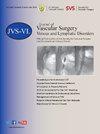黑人和白人患者静脉血栓栓塞率差异的因素评估。
IF 2.8
2区 医学
Q2 PERIPHERAL VASCULAR DISEASE
Journal of vascular surgery. Venous and lymphatic disorders
Pub Date : 2025-05-26
DOI:10.1016/j.jvsv.2025.102270
引用次数: 0
摘要
目的:在美国,与白人相比,医院相关性静脉血栓栓塞(VTE)的发生率在黑人中较高。然而,造成这种差异的原因尚不清楚。在这里,我们利用一个大型的,全国性的队列来评估可能导致静脉血栓栓塞率在黑人和白人患者中的差异的临床因素。方法:我们分析2016年1月至2021年12月在所有退伍军人事务机构连续首次入院的黑人和白人患者。我们首先比较了入院90天内白人和黑人患者的静脉血栓栓塞率,确定了种族与静脉血栓栓塞之间关系的11个潜在混杂因素,并利用这些因素建立了一系列预测静脉血栓栓塞发展的调整后逻辑回归模型。从这些模型中获得的比值比(OR)进行比较,以检验种族、潜在混杂变量和静脉血栓栓塞之间的关系。结果:研究队列包括142456例患者(平均年龄54岁,男性84.7%),其中28.5% (N= 40632)为黑人,71.5% (N= 101824)为白人。该队列中有2.4%的患者在90天内发生静脉血栓栓塞(N=3,455),黑人患者的静脉血栓栓塞率(2.7%)高于白人(2.3%)。结论:在该住院患者队列中,黑人种族是静脉血栓栓塞的主要危险因素,与社会剥夺、血型和手术无关。这种效应可能受到血红蛋白的调节,提示静脉血栓栓塞与种族之间的潜在临床病因。本文章由计算机程序翻译,如有差异,请以英文原文为准。
Evaluation of factors underlying differences in venous thromboembolism rates between Black and White patients
Objective
In the United States, the incidence of hospital-associated venous thromboembolism (VTE) has been found to be higher among Blacks compared with Whites. However, the reason for this difference is not well-understood. Here, we utilize a large, nationwide cohort to evaluate the clinical factors that may contribute to the difference in rates of VTE in Black vs White patients.
Methods
We analyzed consecutive first hospital admissions of Black and White patients to all Veterans Affairs facilities from January 2016 to December 2021. We first compared VTE rates between White and Black patients within 90 days of hospital admission, identified 11 potential confounders for the relationship between race and VTE, and used these to develop a series of adjusted logistic regression models predicting the development of VTE. Odds ratios (ORs) obtained from these models were compared to examine the relationship between race, potential confounding variables, and VTE.
Results
The study cohort consisted of 142,456 patients (mean age, 54 years; 84.7% male), of whom 28.5% (n = 40,632) were Black and 71.5% (n = 101,824) were White. Of the cohort, 2.4% developed a VTE within 90 days (n = 3455), and the rate of VTE was higher in Black patients (2.7%) compared with White patients (2.3%; P < .001). A total of 12 models were developed to examine individual confounders of the relationship between race and VTE. In all models, Black race was associated with increased odds of VTE (OR, 1.06-1.17). The strength of this association remained unchanged in the range of OR 1.13 to 1.16 after adjusting for major covariates including social deprivation index, blood type, and surgery type. When adjusting for hemoglobin, the OR for the association between Black race and VTE was reduced. An inverse correlation was observed between Black race and hemoglobin, with Pearson and Spearman correlation coefficients of −0.17 and −0.180, respectively.
Conclusions
In this cohort of hospitalized patients, Black race is a major risk factor for VTE, independent of social deprivation, blood type, and surgery. This effect may be modulated by hemoglobin, suggesting a potential clinical etiology underlying the trends observed between VTE and race.
求助全文
通过发布文献求助,成功后即可免费获取论文全文。
去求助
来源期刊

Journal of vascular surgery. Venous and lymphatic disorders
SURGERYPERIPHERAL VASCULAR DISEASE&n-PERIPHERAL VASCULAR DISEASE
CiteScore
6.30
自引率
18.80%
发文量
328
审稿时长
71 days
期刊介绍:
Journal of Vascular Surgery: Venous and Lymphatic Disorders is one of a series of specialist journals launched by the Journal of Vascular Surgery. It aims to be the premier international Journal of medical, endovascular and surgical management of venous and lymphatic disorders. It publishes high quality clinical, research, case reports, techniques, and practice manuscripts related to all aspects of venous and lymphatic disorders, including malformations and wound care, with an emphasis on the practicing clinician. The journal seeks to provide novel and timely information to vascular surgeons, interventionalists, phlebologists, wound care specialists, and allied health professionals who treat patients presenting with vascular and lymphatic disorders. As the official publication of The Society for Vascular Surgery and the American Venous Forum, the Journal will publish, after peer review, selected papers presented at the annual meeting of these organizations and affiliated vascular societies, as well as original articles from members and non-members.
 求助内容:
求助内容: 应助结果提醒方式:
应助结果提醒方式:


